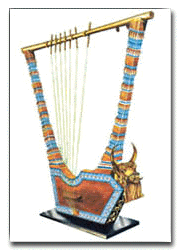|
|
|
 HISTORY |
|
|
History of the Syriac Folk music
 From the early epochs of Christianity, the Syriac music was used within the church to complete the church’s rites. This rich musical inheritance in the Syriac church was, under the long history, formed of two important factors: From the early epochs of Christianity, the Syriac music was used within the church to complete the church’s rites. This rich musical inheritance in the Syriac church was, under the long history, formed of two important factors:
• The syriac folk melodies, which were famous in Mesopotamia before Christianity.
• Musical works written by old famous church leaders like St. Ephraim, St. Jacob Dasroug, St. Severious and others.
These religious melodies became the dominated element in our folk music. Under the development of the social and environmental guise, the Syriac people felt a need for a new musical culture not associated to the church, but expresses their feelings and ideas.
In order to create such a modern folk music, according to Malfonon Nuri Iskandar, you have to study and analyse the church music, its phrases and structure. Then it will be easy to treat and work with new styles, which correspond the demands of music as a manner of expression.
The above-mentioned method used by the Rahbanys in Lebanon who composed may of their musical work on this basis. Many other famous Arab and Turkish composers did the same and their works became very famous.
Our folk music developed with the beginning of the passed century, with the syriac cultural prosperity in Kamishli, Aleppo and Beirut. Motho rhimto
nisho dil, Rhimto dleb warde mzabno, Grishla idi, Hema o Haye and O Habibo were some of the famous songs at that period of time. While deceased Gabriel Assad, Joseph Malki, Nouri Iskandar, Father fawlos Mikhael, Danho Dahho and
Chabo Bahe were also some of the leaders of the folk music’s revolution.
At the early sixties in the passed century, Joseph Malki and Abrohom Lahdo tried to convince some of the Syriac poets to write folk songs with the spoken Syriac but they didn´t succeed. Beacause of the prevalent idea at that time was that Syriac is the Lord´s language, which shall not humiliate by songs. And lyrics in spoken language may not exist in order to preserve the purity of the language.
Chabo Bahé who already in 1962 had written lyrics in the spoken Syriac (Safro Msafro Bsafrayto) wrote “Grishla Idi”, which Joseph Malki composed in 1967. Grishla Idi became the spark of the new form of lyrics and folk music beginning from Kamishli to reach the whole world.
In 1971-1973 Nouri Iskandar implemented a new modern form of Syriac folk music. In cooperation with the "Religious Education´s center - Aleppo" released about thirty singles (SP) in Beirut, sang by a variation of young singers at that time. The biggest share of those songs was to Habib Moussa which made him the most popular singer with his glorious songs like "O Habibo", "Zabno Tloumo", "Zliqé Frisé" and others.
The productive power of the Syriac folk music moved to Europe with the emigration of the Syriac people at the end of the 1960s and the beginning of the 1970s. The first qualitative LP-disc released in Europe-Sweden at the seventies was Joseph Malki’s Azzen Azzen in 1977 (singer Ninib Lahdo).
The development is still in progress both at homeland and in the diaspora. Many new talents has taken over this rich musical inheritance to carry out a new developed Syriac folk music.
By: Infomaster
|
|
«« Go back
|
|

